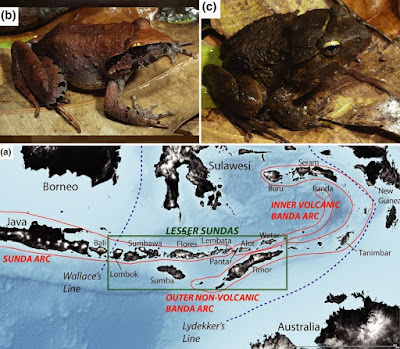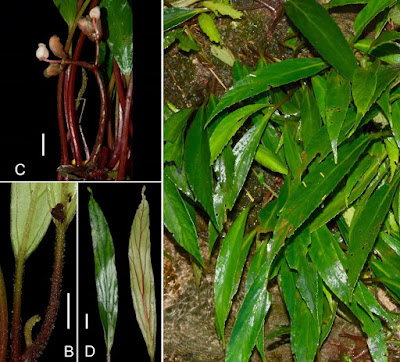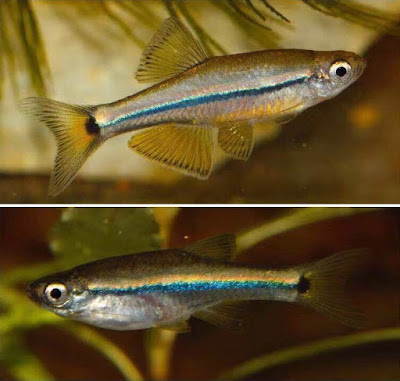[Most Recent Entries] [Calendar View]
Saturday, April 20th, 2019
| Time | Event | ||||
| 2:20a | [Herpetology • 2019] Leap‐frog Dispersal and Mitochondrial Introgression: Phylogenomics and Biogeography of Limnonectes Fanged Frogs in the Lesser Sundas Archipelago of Wallacea
Abstract Aim: The Lesser Sunda Islands are situated between the Sunda and Sahul Shelves, with a linear arrangement that has functioned as a two‐way filter for taxa dispersing between the Asian and Australo‐Papuan biogeographical realms. Distributional patterns of many terrestrial vertebrates suggest a stepping‐stone model of island colonization. Here we investigate the timing and sequence of island colonization in Asian‐origin fanged frogs from the volcanic Sunda Arc islands with the goal of testing the stepping‐stone model of island colonization. Location: The Indonesian islands of Java, Lombok, Sumbawa, Flores and Lembata. Taxon: Limnonectes dammermani and L. kadarsani (Family: Dicroglossidae) Methods: Mitochondrial DNA was sequenced from 153 frogs to identify major lineages and to select samples for an exon‐capture experiment. We designed probes to capture sequence data from 974 exonic loci (1,235,981 bp) from 48 frogs including the outgroup species, L. microdiscus. The resulting data were analysed using phylogenetic, population genetic and biogeographical model testing methods. Results: The mtDNA phylogeny finds L. kadarsani paraphyletic with respect to L. dammermani, with a pectinate topology consistent with the stepping‐stone model. Phylogenomic analyses of 974 exons recovered the two species as monophyletic sister taxa that diverged ~7.6 Ma with no detectable contemporary gene flow, suggesting introgression of the L. dammermani mitochondrion into L. kadarsani on Lombok resulting from an isolated ancient hybridization event ~4 Ma. Within L. kadarsani, the Lombok lineage diverged first while the Sumbawa and Lembata lineages are nested within a Flores assemblage composed of two parapatrically distributed lineages meeting in central Flores. Biogeographical model comparison found strict stepping‐stone dispersal to be less likely than models involving leap‐frog dispersal events. Main conclusions: These results suggest that the currently accepted stepping‐stone model of island colonization might not best explain the current patterns of diversity in the archipelago. The high degree of genetic structure, large divergence times, and absent or low levels of migration between lineages suggests that L. kadarsani represents five distinct species. Keywords: amphibians, exon‐capture, genomics, Indonesia island, biogeography, phylogeography
Sean B. Reilly, Alexander L. Stubbs, Benjamin R. Karin, Ke Bi, Evy Arida, Djoko T. Iskandar and Jimmy A. McGuire. 2019. Leap‐frog Dispersal and Mitochondrial Introgression: Phylogenomics and Biogeography of Limnonectes Fanged Frogs in the Lesser Sundas Archipelago of Wallacea. Journal of Biogeography. DOI: 10.1111/jbi.13526 | ||||
| 8:54a | [Botany • 2019] Begonia rheophytica (Begoniaceae) • A New Species of Begonia from northern Myanmar with An Updated Checklist of Begonia in Myanmar
Abstract A new species, Begonia rheophytica (§ Platycentrum), is described from northern Myanmar; it was initially confused with B. rhoephila, which is confined to Peninsular Malaysia. Comparison with other species with a rheophytic leaf shape is made. This new addition brings the number of currently recognised Begonia species in Myanmar to 73. An updated checklist of Myanmar Begonia species is also included. Keywords: Biodiversity, Hkakaborazi National Park, Kachin State, Myanmar, taxonomy Begonia rheophytica M.Hughes, sp. nov. § Platycentrum. Etymology. Named after the rheophytic habit of the species (rheo-, pertaining to flowing water [Greek]). M. Hughes, M. M. Aung and K. Armstrong. 2019. An Updated Checklist and A New Species of Begonia (B. rheophytica) from Myanmar. Edinburgh Journal of Botany. DOI: 10.1017/S0960428619000052 | ||||
| 3:10p | [Ichthyology • 2019] Tanichthys kuehnei • A New Species (Cypriniformes: Cyprinidae) from Central Vietnam
Tanichthys kuehnei, new species, is described from a stream in the Bach Ma Mountains in Hue Province in Central Vietnam. The new species differs from its congeners by having more branched rays in anal fin (9 1/2 vs. 7-8 1/2 in T. micagemmae and 8 1/2 in T. albonubes and T. thacbaensis). Morphological and genetic characters suggest it to be closer related to T. micagemmae, the only other species of Tanichthys known from Central Vietnam. Tanichthys kuehnei differs from T. micagemmae by having a white anal-fin margin (vs. red). Jörg Bohlen, Tomáš Dvorák, Ha Nam Thang and Vendula Šlechtová. 2019. Tanichthys kuehnei, New Species, from Central Vietnam (Cypriniformes: Cyprinidae). Ichthyol. Explor. Freshwaters. DOI: 10.23788/IEF-1081 |
| << Previous Day |
2019/04/20 [Calendar] |
Next Day >> |








